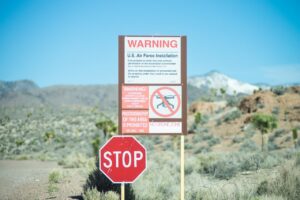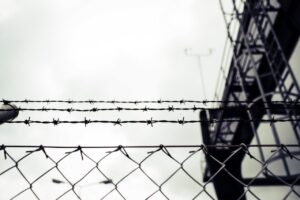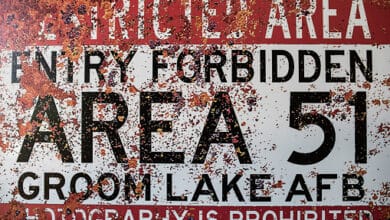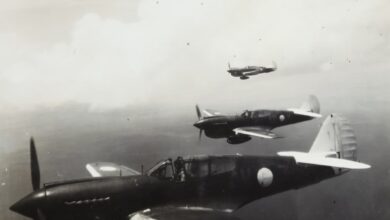Area 51 Secrets: The Mysterious History of the Top-Secret Military Base
Area 51 has become synonymous with government secrecy. Located in a remote part of the Nevada desert, the base has long been rumored to house top-secret research on extraterrestrials and advanced technologies.
While much about Area 51 remains classified, some details about its history and operations have come to light over the years. Area 51 conspiracy theories are very common and a lot of crazy theories exist. Let’s dig into some facts and myths!
The Origins of Area 51
Area 51 was established in 1955, during the early years of the Cold War between the United States and the Soviet Union. The U.S. government needed a remote, secret location to test new aircraft technology as it raced to stay ahead of Soviet aviation advances.
The area surrounding Groom Lake, a dry lake bed in the Nevada desert, was an ideal spot. It was remote, far from any major cities or major civilian flight paths. The lakebed provided a long runway that could be used for testing experimental planes. And the surrounding mountains and valleys provided cover and seclusion.
any major cities or major civilian flight paths. The lakebed provided a long runway that could be used for testing experimental planes. And the surrounding mountains and valleys provided cover and seclusion.
In the 1950s, the base at Area 51 was known as Watertown Airstrip before being designated Area 51. The name “Area 51” refers to its map designation. However, specifics about the base were kept secret from the public for decades. Even Area 51’s existence was not officially acknowledged by the U.S. government until 2013.
U-2 Spy Planes and Cold War Projects
Much of what is known about Area 51’s early operations centers around the testing of the U-2 spy plane. Developed in secrecy by Lockheed Martin in the 1950s, the U-2 was a high-altitude reconnaissance aircraft capable of flying at 70,000 feet. It was designed to fly over the Soviet Union and take photographs that could reveal information about Soviet military capabilities.
The U-2 was an incredibly advanced and secret aircraft for its time. To keep the plane’s development under wraps, extensive testing needed to be done in isolation. Area 51 provided the perfect secluded location. The first U-2 flew at Area 51 in August 1955. The U-2 underwent extensive testing from Area 51 before being deployed by the CIA in overseas intelligence-gathering missions.
In addition to the U-2, Area 51 was the development and test site for other covert Cold War aircraft, including the A-12 Oxcart and the SR-71 Blackbird. These planes flew at unprecedented speeds and altitudes, allowing them to evade Soviet air defenses. Area 51 allowed the aircraft to be tested safely away from public view.
The level of secrecy surrounding Area 51 was extraordinary during the 1950s and ’60s. Even civilian pilots were not allowed in the restricted airspace around the base. If a plane accidentally strayed into the airspace, fighter jets would be scrambled to intercept it.
Expansion and Later Use of the Base
Over the decades, Area 51 continued to expand both in size and operations. The base grew to encompass a large section of land measuring roughly 23 by 25 miles. While the base remains very secretive, some details of later operations have leaked out:
- In the 1970s, reconnaissance planes like the SR-71 Blackbird continued to be tested from Area 51. The base
 was also reportedly used to develop stealth technology that could help aircraft evade enemy radar detection.
was also reportedly used to develop stealth technology that could help aircraft evade enemy radar detection. - In the 1980s, Area 51 was rumored to be the site of development for a new aircraft technology called HAVE BLUE which led to the creation of stealth fighter planes. The base was expanded significantly to accommodate large hangars and longer runways able to support new classes of aircraft.
- After the end of the Cold War, the focus shifted from defense to aerospace technology and weapons systems development. Rumors circulated that scientists at Area 51 were studying alien spacecraft (more on this later).
- After the 9/11 attacks, Area 51 was believed to have shifted to counterterrorism and improving aviation security. The Air Force Operating Location (AFL) on the west side of Area 51 developed techniques for defeating improvised explosive devices.
Of course, the details of precisely what goes on at Area 51 today remain murky due to the high levels of secrecy. But the history shows how the base has continually evolved to support classified research and development projects important to U.S. national security.
The Area 51 Aliens Conspiracy Theory
No history of Area 51 would be complete without examining the alien conspiracy theories. Rumors have swirled almost since the birth of Area 51 that the site houses recovered alien spacecraft and conducts research on extraterrestrial life. These rumors were sparked by reported UFO sightings in the areas around Area 51 and fueled by the extreme secrecy enveloping the base.
In 1989, a man named Bob Lazar claimed in an interview that he had worked on reverse engineering alien spacecraft at a site near Area 51 called S-4. Lazar said he examined propulsion systems on saucer-shaped craft of extraterrestrial origin. His extraordinary claims stoked rumors that scientists were harvesting alien technology at the base.
spacecraft at a site near Area 51 called S-4. Lazar said he examined propulsion systems on saucer-shaped craft of extraterrestrial origin. His extraordinary claims stoked rumors that scientists were harvesting alien technology at the base.
While Lazar’s allegations have been met with much skepticism, they succeeded in sparking public intrigue. Area 51’s reputation as a site for alien activity was further amplified in popular culture through shows like The X-Files and movies like Independence Day. Tourists and UFO enthusiasts have flocked to the area around Area 51, seeking a glimpse of alien evidence.
However, the U.S. government has never acknowledged that Area 51 houses alien life forms or spacecraft. Air Force reports declassified in the 1990s made no mention of aliens. And most skepticism centers around the lack of any substantiated evidence that aliens have ever touched down there. Still, the association between Area 51 and extraterrestrials persists in pop culture and public imagination.
Area 51 remains shrouded in mystery and secrecy decades after its establishment. While most of its operations may center on advanced terrestrial aerospace projects, the conspiracy theories remain intriguing. The aura of intense secrecy surrounding Area 51 is likely to continue sparking public imagination and rumors about what may lie behind its closed doors. But the full truth remains elusive.
The Secret OXCART Project
In 2007, previously classified documents were publicly released, providing new insights about Area 51’s secret operations during the Cold War. The documents revealed details about OXCART, the codename for the A-12 reconnaissance plane developed in the late 1950s and early 60s.
The OXCART project was so confidential that even non-essential workers at Area 51 did not know what was happening there. The complete information about OXCART was kept in just two copies of a 400-page document kept in separate safes. Even most high-ranking military officials were kept in the dark.
The extreme secrecy was due to fears that the Soviets would find out about the project and copy it. If they detected the unique sound of the jet engines, they could deduce its unique characteristics. So exhausting security measures were taken to conceal everything about the plane from prying eyes and ears.
While OXCART never saw full-scale deployment, it pioneered design concepts that fed into the development of subsequent aircraft at Area 51, like the SR-71 Blackbird spy plane. The disclosure of the OXCART documents provided a rare window into the intense secrecy surrounding Area 51’s Cold War projects.
The Mystery of the Cammo Dudes
While the personnel at Area 51 focus on classified projects, some of the most public-facing workers at the base work hard to keep people away and maintain secrecy. They are known colloquially as “Cammo Dudes.”
Cammo Dudes patrol the areas around Area 51, looking for trespassers and onlookers. They wear camouflage outfits and drive white trucks with no license plates. When people are spotted near the perimeter, the Cammo Dudes often follow them and order them to leave. Their job is essentially to act as the security forces, intimidating potential intruders.
What is fascinating about the Cammo Dudes is how little is known about them. They tend to remain silent and are not believed to be military employees. It has been speculated that they actually work for private contractors hired to provide security. But their shadowy presence has piqued public curiosity and added to Area 51’s mystique as a place with sinister secrets to hide.
Lawsuits Over Toxic Waste Disposal
In 1994, five contractors who had worked on projects at Area 51 in the late 1980s and early 90s filed a lawsuit against the US Air Force and EPA. They claimed illegal dumping of hazardous waste at Area 51 had caused health problems like respiratory illnesses and cancer.
The lawsuit alleged that large quantities of toxic waste from classified aircraft programs were buried in trenches on the site. This included jet fuel, explosive compounds, and industrial solvents. The contractors said this toxic exposure resulted in chronic illnesses.
While the case was eventually dismissed on the grounds that it jeopardized state secrets, it highlighted health and safety concerns related to hazardous waste disposal at Area 51. It also underscored the difficulty of getting full information about incidents at such a secretive location. The environmental toll of activities at Area 51 remains murky at best.
The Mysterious Janet Airlines
The public is kept in the dark about much of what happens at Area 51. But keen observers over the years have uncovered clues by watching the periphery of the base, including the aircraft that service it.
Janet Airlines is the unofficial name for the airline that operates flights to and from Area 51. The airline appears to be run by a private company on behalf of the Air Force. Its planes have no logos or identifying markings. The terminal where Janet’s flights depart near Area 51 seems designed to offer discretional privacy to workers coming to the base.
What piqued people’s curiosity were the planes themselves. Janet appeared to operate multiple Boeing 737-200 aircraft. This is an older model of 737 no longer used by major commercial airlines. Why would these outdated planes be used for Area 51 workers? Speculation centered around the idea that they were deliberately chosen so they could more easily be “sanitized” of any advanced technologies or secrets before leaving the base.
The Janet airline flights and terminal illustrate the lengths to which planners go to maintain Area 51’s veil of secrecy. Every aspect of transportation to and from the base is designed to limit its exposure to the public. And that only heightens fascinating speculation about what is being hidden.
Potential Environmental Hazards
In 2019, the Air Force released a study examining potential contamination at Area 51 and risks to the surrounding environment. The draft report was part of a required environmental review related to the potential expansion of the Nevada Test and Training Range, which surrounds Area 51.
The report examined past disposal methods for classified hazardous wastes at Area 51. It noted that practices like burn pits and burial of waste in trenches may have contaminated soil and groundwater. There are concerns that these contaminants might be migrating offsite.
Additionally, the report highlighted the deterioration of buildings, pipes, and storage tanks on the base, noting some infrastructure dates back over 50 years. Deteriorating facilities raise the risk of accidental hazardous material releases.
While the Air Force has said potential pollution at Area 51 does not pose an immediate public health hazard, its draft report highlights the lingering environmental legacy of past operations. It shows how even basic issues like waste disposal become complex and murky when so much is classified.
The Secret Area 52
In 2017, recently declassified documents revealed the existence of a separate secret base called Area 52 within the Nevada Test Site boundaries. Built in the mid 1950’s, Area 52 was established for the secret testing of spy planes, just like Area 51. In fact, Area 51 and Area 52 appear to have been built at the same time, suggesting they both supported complementary classified programs.
Specifics about Area 52 remain scarce. It seems to have been a smaller sister base meant for additional clandestine aircraft tests away from Area 51. The creation of a whole additional secret base highlights just how far the Air Force would go to compartmentalize its covert operations during the Cold War.
Prominent Figures Linked to Area 51
In 2014, a physicist named Bob Lazar gave an interview claiming he briefed scientist Edward Teller about his work reverse engineering alien spacecraft at Area 51. Edward Teller is known as the “father of the hydrogen bomb” – though not everyone believes Lazar’s extraordinary claim.
However, there are indications that Teller may have been linked to Area 51. Declassified documents show he met with an Area 51 commanding officer in 1958. This hints that major important scientists may have been involved with secret projects at the base. Exactly what sorts of work Teller may have consulted on remains unknown.
The Mysterious S-4 Facility
In addition to mentioning Edward Teller, Bob Lazar discussed working at a separate facility called S-4 adjacent to Area 51. S-4 was described as a hidden base carved into the side of a mountain – the perfect spot for testing alien spacecraft away from prying eyes.
While S-4 has never been acknowledged officially, some Area 51 watchers have theorized about its possible location based on testimonies. Could the shadowy S-4 really be Area 51’s most closely guarded facility for examining extraterrestrial technology? Without substantiation, its true purpose remains a tantalizing enigma for those who believe in secret alien projects.
The new details that trickle out over time show that there may still be entire secret facilities, operations, and connections hidden within the Area 51 complex. The newly revealed secrets often raise as many questions as they answer as the world tries to pierce the veil over Area 51’s past and present activities.
Conclusion
The new details that have emerged help peel back a few of the layers of secrecy around Area 51. But they also raise as many questions as they answer. Hints of environmental issues, covert operations, and mysterious workings suggest there are many more hidden facets of Area 51 still to uncover.
The incremental revelations about Area 51 show that even when classified information comes to light, it often opens doorways to new mysteries. Area 51’s history of advanced aviation development and its association with aliens have cemented its legendary status.
But there are likely many more strange and fascinating facts about Area 51 that have yet to reach the public eye. Its full history remains cloaked behind layers of enigma that beg the imagination to speculate and wonder.

